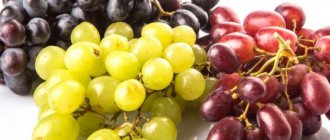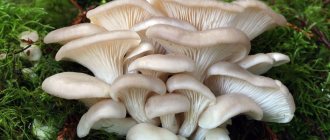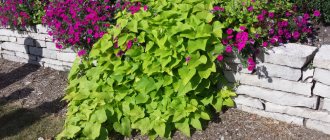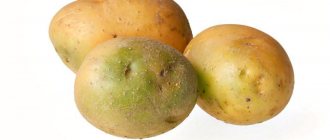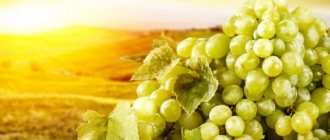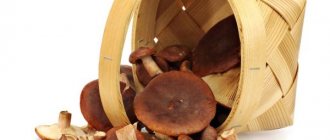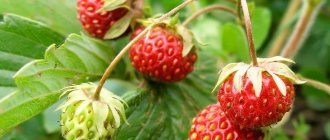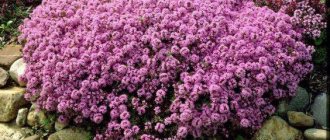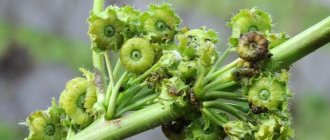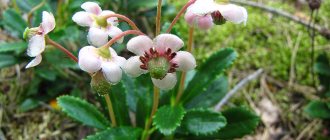What kind of berry is cranberry?
Cranberry fruits contain many rare trace elements
The genus cranberry itself has three types: ordinary, small-fruited, and large-fruited. The latter is sometimes also called American. In Russia, common and small-fruited varieties grow. The second lives mainly near the Arctic Circle, in tundras, forest-tundras, and northern swamps. The common one is found everywhere in wet hollows or swamps throughout Russia, excluding the southern Volga region, Kuban, and the Caucasus. In Europe it grows north of Paris, and in North America - from Chicago, covering all of Canada. The range of the large-fruited variety covers the Appalachian Mountains region.
This berry loves damp places, undisturbed by human activity, and is very sensitive to the state of the environment. So most often cranberries grow in taiga swamps or in wet lowlands and mountain hills. The main thing is that there is enough water and the soil is fertile.
Cranberry fruits contain many rare microelements: selenium, lutein, manganese, zeaxanthin. They are used in the treatment of colds and inflammatory diseases, as an antipyretic and suppressant of pathogenic microflora. Cranberry fruits are also used to treat rheumatism and scurvy. Since they contain a lot of vitamins C and K, they are not recommended for consumption by people suffering from stomach ulcers or other diseases of the digestive system. Cranberry juice can act as an irritant.
Before the invention of antibiotics, folk healers used willow bark and cranberry juice; their principle of action is similar to penicillin, although weaker.
How cranberries bloom in a swamp
Flowering times vary in different regions. In the south of the country the shrub blooms in the second half of May. In the northern regions, the dates are shifted until the beginning of June.
Flowering begins at the ends of last year's shoots. The flowers are small, drooping, regular in shape, located on long stalks, collected in brushes of 4 pieces. Petals are pale pink. The period lasts up to three weeks.
The ovary is formed from the bottom of the flower, has 4 chambers, each containing many grains. At the beginning of development, the fruits are white, gradually acquire a characteristic color, and fill with juice.
The photo shows what a blooming cranberry looks like in a swamp.
Characteristic
Cranberries are evergreen creeping small shrubs from the genus Vaccinum of the Heather family (the most famous representatives of the genus are lingonberries, blueberries, blueberries). In nature, there are a huge number of varieties of this plant: more than a hundred species of this berry grow in America alone, while the development of new varieties continues.
Cranberry bushes can be seen in many countries of the northern hemisphere: in the forests of Europe, Asia, and North America. The berry feels great both in the north of Italy and near the Arctic Circle; there is a lot of it in Siberia and the Far East.
Although many people, when asked where cranberries grow, will not hesitate to name a swampy area, in reality the berry does well in different types of soil, since it is undemanding in terms of mineral nutrition. True, in the wild it still prefers damp places, despite the fact that it is a light-loving plant.
Cranberry bushes growing in Europe and America differ significantly from each other: the European berry is smaller and full of spots. The fruits also differ in their cell structure: the American berry contains three sets of chromosomes, while the European berry has two.
Another difference is that the American berry contains air chambers that allow it to float on the surface of the water.
This greatly facilitates the collection of fruits: berries on cranberry plantations are grown in special checks. After ripening and hand-picking the best berries, they are filled with water and a special technique is launched, which, by whipping the water, causes the ripened fruits to come off and float. Then they are gradually brought to one of the edges of the check, where the clean and washed ones are scooped out into specially prepared containers.
Cranberry bushes are also divided into wild and garden, which can be grown in your own garden:
- Swamp cranberry is the most common cranberry in the eastern hemisphere; the berries of this variety are bright red. Swamp cranberry contains a huge amount of vitamin C, as well as many micro- and macroelements. People have long noticed the beneficial properties of swamp cranberries and learned to use them: dried cranberries and cranberry compote were used in the treatment of vitamin deficiency, colds, and sore throats. The juice of the berry was used to lubricate open wounds to speed up healing. For example, Indian shamans made compresses from the juice of the berry, thanks to which the poison received from a wound with a poisonous arrow was drawn out of the wounds (the benefits of cranberries in treatment were enormous).
- Wild berries are considered one of the most useful berries growing in the wild; they grow not only in wetlands, but also in peat soil.
- Garden cranberry - this species can be grown on your own plot: it feels excellent in peat-rich soil. The berries of this variety are much larger than those of the wild plant, and planted shrubs can bear fruit for about half a century.
Popular varieties
The varietal diversity of cranberries includes only 4 species, which, in turn, are divided into several varieties:
- large-fruited;
- four-petalled (swamp);
- small-fruited;
- gigantic.
The greatest benefit comes from varieties of large-fruited cranberries, the diameter of whose berries reaches 1-2 cm. In early varieties, the berries ripen at the end of September, and in later varieties - in October. The ripeness of cranberry fruits is indicated by the bright red color of the skin. Harvesting can be done before the first frost. Here are the most popular cranberry varieties.
Cranberry "Pilgrim"
The most common plant variety that can be found in almost every garden. The Pilgrim variety is late, but very fertile, with strong growth of new shoots every spring. The fruit is large, oval, covered with a waxy coating, completely ripe when it turns purple-red. Photos of Pilgrim cranberries are presented below.
Cranberry "McFarlin"
A late variety with dark red, slightly oblong fruits. They are great for canning. When raw, they are stored very poorly, quickly losing their original color. This variety is most often grown for commercial purposes, making jam and fruit drinks from it.
Cranberry "Howes"
Another late variety of cranberry, but less fertile than the previous ones. Its fruits are best suited for long-term storage. The berries are medium-sized, spherical and shiny. The plant produces many fruit-bearing young shoots, thanks to which this variety is often used as an ornamental. It looks especially beautiful on the site during the flowering period from June to July.
Cranberry "Black early"
This variety is distinguished by a very early fruiting period. Already at the end of August, gardeners can harvest a full harvest, consisting of small, pear-shaped berries of a dark red color with a shiny skin. Photos of Black early cranberries can be seen below.
What does cranberry look like and its beneficial properties?
Cranberry is a plant with many beneficial properties. In folk medicine, the fruits and leaves are used to treat many diseases.
- Cranberry teas, fruit drinks and decoctions:
- have a diuretic effect;
- relieve inflammation;
- destroy harmful bacteria;
- reduce the temperature.
You can use cranberry preparations for treatment only on the recommendation of a doctor. If self-prescribed without prior testing, the patient may experience side effects in the form of allergies or intolerance to the product.
The plant is divided into four main types: common cranberry, small-fruited, large-fruited and Vaccinium red-fruited. The cultures are somewhat similar in appearance, but they also have significant differences. Their distribution areas also differ.
Ordinary
Common cranberry is an evergreen plant of semi-shrub type. The culture grows wild in the territory of Eurasia in the north and central region. The stems are several millimeters in diameter, climbing, with an average length of 0.8 m, covered with dark brown bark with a red tint. Fruiting branches rise higher than others.
The leaf plates are egg-shaped and attached to the shoots on petioles. The color of the leaves is green, with a bluish coating on the inside. The fruits are spherical, less often pear-shaped, growing up to 1.5 cm in diameter. The color of the berries is bright red.
Small-fruited
The small-fruited variety belongs to the Red Book. The branches are weaving, grow up to 25–35 cm. The leaf blades are no longer than 0.6 cm, dark green in color with a gray coating on the inside. The average diameter of the berries is 6–7 mm, the color is red.
Large-fruited
Wild large-fruited cranberries grow in North America. Cultivated forms are grown in the USA and Canada. The large-fruited variety is distinguished by large berries. The average diameter of the fruit is 2.5 cm.
Video: How large-fruited cranberries grow on the plot
The leaves are green at the beginning of the growing season and become dark red in autumn. By the end of the first half of September, fruits with dark red skin begin to ripen. Unlike others, this species has straight and creeping shoots. The berries ripen on erect branches.
Vaccinium redfruit
Red-fruited vaccinium is divided into two botanical subspecies. Different forms are found in the USA, Korea, China, and Japan. The distribution area of the crop is forest, and shrubs of this species love shaded, hard-to-reach places.
The plant looks like a bush up to 1.5 m high. The fruits are translucent, dark red in color. Sometimes the plant is classified as a member of the genus Vaccinium or considered an independent species. In most cases, the crop is still considered cranberry.
Description
Absolutely all species are small evergreen shrubs creeping along the ground with flexible thin stems from 15 to 30 cm that are rooted in the ground. The plant lives for a long time: the age of some species exceeds a hundred years.
The mineral solutions, nutrients and trace elements necessary for the cranberry bush enter the plant through the fungus located on its roots, which is tightly connected by its threads to the root system of the bush. Mushroom threads pull the necessary solutions from the soil, after which they transfer them to the roots of the bush.
The leaves of cranberry bushes are dark green, ovate or oblong, arranged in a spiral, with one leaf coming from each node of the stem. The length of the leaves ranges from 3 to 16 mm, width – from 1 to 6 mm. Interestingly, there is wax on the bottom of the leaf, which prevents water from flooding the stomata, through which evaporation and gas exchange between the plant and nature occurs.
Cranberry bushes bloom for about eighteen days in late May - early June. The flowers of the shrub are pink or light purple, and the flower itself usually has four petals, but often has five.
Every year, several hundred hard dark red berries with a diameter of 8 to 16 mm appear on one bush. They ripen at the end of summer and are able to remain on the plant until spring without losing their qualities.
Ninety percent of cranberry berries consist of water, and they contain such a huge amount of medicinal properties that no one doubts the benefits of cranberries in our time. Among the organic compounds we can highlight:
- Vitamins A, B, PP, K1, C (interestingly, there is as much vitamin C here as in lemon, orange, grapefruit, strawberry);
- Fructose, glucose, sucrose, pectins;
- Phenol acids – reduce the risk of atherosclerosis by reducing the amount of bad cholesterol in the body;
- Potassium, iron, calcium, phosphorus, manganese, copper, iodine, tin, boron, zinc, silver, etc.
- Organic acids - primarily citric, malic, oxalic, benzoic, quinic.
Where and how cranberries grow in nature
All varieties of crops naturally grow in marshy areas. Among the places of growth:
- coniferous sphagnum forests;
- raised bogs;
- transitional swamps;
- swampy shores of lakes.
The bushes are spread on the ground and intertwined with branches, creating a kind of carpet.
Cranberries grow in “foci”, between which there is a fairly large distance. The shrub can also be planted in your own garden. An important condition is acidic soil with pH = 2.5. The composition of the soil is not important.
Medicinal properties of cranberries
Traditional medicine has long adopted this valuable taiga fruit. But it is important to know for which diseases cranberry really becomes a reliable assistant and brings benefits. What does the “northern healer” treat and what recipes can you safely use for emerging diseases? Cranberry is used:
- To cleanse the intestines, removing stagnant feces and toxic compounds in their composition. The recipe is simple: you need to mix cranberry and beet juice in equal proportions and drink 3-5 sips 3 times a day. The same remedy is recommended for cramps and constipation.
- For colds, to relieve inflammation, prepare a mixture of equal parts of aloe juice, cranberry, lemon, honey and vodka. Sugar is added as desired. The mixture is stored in a cool place and taken three times a day, 2 tbsp. l.
- To restore physical strength, use cranberry juice, half diluted with water. The drink is useful for people involved in sports or physical labor. It will give you vigor due to the multivitamin complex in its composition.
- For hypertension, a mixture of cranberries (500 g) and sugar (150 g), diluted with 250 ml of water, helps. The mixture is boiled for 10 minutes, cooled and diluted half with water. It is enough to take a glass of the product per day.
- For diabetes, it will help normalize the amount of sugar in the blood. To do this, grind a handful of cranberries, pour in 250 ml of hot water and let the drink infuse for an hour. Take twice a day in a volume of 50 ml.
- As a preventive measure for problems of the genitourinary system, diluted cranberry juice (1:3) 100 ml daily is useful.
- For diarrhea, a folk remedy has been created based on berries and leaves in equal parts. The mixture is boiled for 5 minutes, pouring 500 ml of hot water. Take 4 times a day, 130 ml.
Cranberry treatment is useful as a disease prevention or it is used as an additional, supportive agent during drug therapy when the disease is already developing.
When does the berry begin to ripen and the harvest time in Russia?
Cranberries can be harvested in summer, autumn and spring. Most often, they begin to collect it in the fall - in September-October, before frost . However, a distinctive feature of cranberry fruits is the ability to overwinter on the plant. Frost does not damage the berries, but only accumulates sugar. This is why many people prefer to pick cranberries not in the fall, but in the spring.
The chemical composition as a percentage per 100 g of fruit is as follows:
| Dry matter | 11,75 |
| Water | 88,25 |
| Sugar | 2,84 |
| Lemon acid | 2,45 |
| Cellulose | 2,01 |
| Pectin | 0,73 |
| Nitrogenous substances | 0,32 |
| Ash | 0,22 |
The ratio of these elements varies depending on the growing conditions and the time of berry picking.
Summer harvest cranberries are firm, white or not fully colored . Over time, it ripens, but retains a lot of acid and does not gain the required amount of sugar. This berry is neither tasty nor juicy. Ripened cranberries have less nutrients, more bitterness, and are poorly stored.
When picking, pay attention to the color of the fruit. Experienced pickers prefer to take cranberries that have acquired a dark purple hue. It is believed that in such a berry the concentration of biologically active substances is maximum.
Harvesting cranberries in autumn
Spring cranberries that have overwintered under the snow are much sweeter than autumn ones, but there is almost no vitamin C left in them. Berries from the autumn harvest have more pectin , which is important if the fruits are intended for processing or confectionery use. Microorganisms responsible for fermentation processes remain active on the skin of autumn cranberries. Therefore, this berry is better suited for winemaking.
Due to the reduced percentage of acid, spring snow cranberries are stored worse . The transportability of autumn-picked berries is also better.
Care
Lighting
The plant prefers open sunny glades. It can grow quite productively in partial shade, but must receive at least 4 hours of direct sunlight per day. When cranberries ripen in the shade, the fruit does not turn red and, accordingly, is not suitable for consumption.
The soil
As with all plants of the heather family, the plant needs acidic (medium acidic), preferably humus soil with plenty of moisture. The substrate should be humus, easily permeable (i.e., well-drained), with a pH of 3.2-4.5 (acidic peat soil is best suited).
Watering
Crane grass has a fairly shallow root system and dries out easily in hot weather, so systematic irrigation and watering of the plants is necessary. Soft rainwater is best suited for irrigation. Experienced gardeners place garden foil with small holes at a shallow depth (about 30-35 cm) under the roots of large-fruited cranberries. Foil limits the rapid absorption of water deep into the ground. Cranberries practically do not tolerate drought (with the exception of a few varieties), but at the same time they can withstand minor floods for a short time (no more than 5-7 days).
Fertilizers
During the active growing season, cranberry bushes can be fed with a small amount of nitrogen fertilizer. It is preferable to use a combined universal fertilizer for acidophilic plants. The nutritional composition is added to the soil in 3 stages:
- in early spring;
- during the period of bud formation;
- closer to autumn, during the period of full ripening of berries.
As a rule, crane bushes are not tall, so if you notice excessive elongation of the shoots, it means you overdid it with nitrogen fertilizers. Excessive branch growth will negatively impact the number of berries when it comes time to harvest cranberries. Instead of a lot of fruit, you will get a lush bush with large green leaves.
Just before frost, a small amount of dry mineral fertilizers with phosphorus and potassium are added to the soil, which will allow plants to better prepare for winter hibernation.
Preparing for winter
Cranberries tolerate frost well down to -10 degrees Celsius. But if severe frosts rage in your region, for the winter the crane bushes are covered with straw or wrapped in burlap, which is covered with sawdust.
Trimming
If the bushes of the plant are more than 3 years old, it is necessary to cut off approximately 1/3 of the thickest branches. Corrective pruning is carried out in early spring and involves removing overgrown shoots. Thickened stems produce much fewer berries. After harvesting, in October, all damaged or broken shoots must be removed.
Diseases and pests
Cultivated varieties of cranberries are not susceptible to pests and diseases , so bush care is limited to pruning and regular watering. For preventive purposes, you can spray the bushes with garden oil or soap solution. But this procedure is performed only until fruits appear on the branches.
Collection and storage of berries
People have been collecting healthy berries for a long time. This culture, due to its special distance from human habitation, requires great responsibility and attention from berry growers. It is more difficult to harvest than lingonberries or blueberries. The fact is that it spreads along the soil, intertwined with a carpet of thin branches. In other words, cranberries grow like any marsh grass.
When you come across a cranberry tree, you can’t immediately see where the berries are, which look like ruby beads. They are hidden almost right next to the soil under the greenery. For ease of collection, people use special long combs made of wood or bone. Lifting the branches with them makes it very convenient to remove berries from the plant.
When you come across a cranberry tree, you can’t immediately see where the berries are, they look like ruby beads
The harvest ripens late, later than all other forest berries. Can be collected until the winter cold. Frosts are not scary for her.
Now let's look at step-by-step instructions for storing cranberries:
- Wash the berries, remove crushed, damaged, overripe ones
- We prepare an enamel bucket or large jar, thoroughly wash the container with soda and no other detergents.
- Pour containers with water reserve into the washed container.
- Fill everything with cold boiled water so that the berries are hidden. The water level should be about two centimeters above the berries.
- Cover the top with parchment and tie it with a tourniquet.
- Place the soaked berries in a cool room, out of direct sunlight.
In this form, the fruits will be stored all winter, without losing either taste or usefulness. There are variations of this recipe for storing cranberries. This is soaking in sugar syrup. All steps are similar to those above, only we use cold syrup instead of water. You can also store the crop under pressure. The berries, laid out in containers and filled with water, are pressed down with a wooden circle, on top of which a load is placed. Also keep this in a cool place.
The berries, laid out in containers and filled with water, are pressed down with a wooden circle, on top of which a load is placed
Cranberry juice, as well as cranberry juice, are also easily stored without becoming sour or moldy. This is thanks to large doses of ascorbic and folic acid, which work as a natural preservative.
Diseases and pests
As a rule, cranberries are susceptible to attack by pests and various diseases if prevention methods are not followed - regular weeding, loosening, and rejuvenation of bushes. In addition, cranberries are susceptible to fungi and viruses.
Diseases
| Diseases | Cause of occurrence | Symptoms | Fighting methods |
| Snow mold | Fungal infection that occurs during spring when the plant is under snow | After the snow melts, the leaves and shoots become covered with reddish-brown spots. Gradually the foliage turns gray and falls off | As a preventive measure and to preserve varieties, cranberries are prepared for the winter by freezing - cold water is poured into the holes around the bushes to freeze them. The affected plant is sprayed with foundationazole |
| Phomopsis | Fungus | The foliage and stems first turn yellow, then wither and do not fall off. Flowers damaged by the fungus turn black, and gray spots appear on the stems. | To suppress outbreaks, the crop is sprayed with fungicidal agents several times a season. |
| Monilial burn | Fungus formed due to prolonged bad weather | The fungus quickly spreads over the surface of leaves and stems, which turn gray and dry out. Even harvested, seemingly healthy fruits are subject to rotting. | Spraying the plant with fungicidal solutions in the spring and during the summer. |
| Terry | Virus | The foliage and shoots distort their shape and twist so that the appearance of the bushes becomes like a broom. | Affected plants are dug out of the ground and burned. The area is treated with fungicides |
| Botrytis | Fungus that forms in wet weather | It affects all the outer parts of the plant, on which a fluffy coating appears. Another name for the disease is gray mold | The plant is sprayed with foundationazole or topsin |
| Gebber spot | Fungus | Foliage and fruits fall from the plant, the plant weakens, stops bearing fruit, brown spots with a dark-colored rim appear on the foliage. | Prevention - spraying with fungicide. If a plant is damaged, it is removed and burned. |
| Pestalocy | Fungus | Spots on the outer parts of the plant first turn brown and then gray, and young stems and shoots dry out and become distorted. | Preventive spraying of plants with copper oxychloride |
Pests
Among the most dangerous crop pests are:
- lingonberry leaf roller;
- gypsy moth;
- moth;
- apple scale insect.
In total, about 40 pests are dangerous to cranberries. The main reason for its occurrence is considered to be untimely loosening of the soil and failure to remove weeds. In addition, organically applied fertilizers can also affect the development of many pest larvae. To prevent the proliferation of pests in the soil, gardeners recommend mulching the soil.
Treatment of plants with insecticidal solutions is used as chemical agents, as a method of prevention and treatment.
Cranberries in the forest and garden
Gardeners and naturalists have long tried unsuccessfully to grow swamp sweets in their own plots. As in the case of lingonberries and blueberries, it turned out that the European cranberry is a plant too dependent on the general ecosystem of the forest, which is why attempts to transfer it to the garden failed every time. Cultural forms of this forest delicacy appeared relatively recently, from the end of the 19th century in North America. Breeders developed the first successful varieties of garden crops based on large-fruited cranberries growing only there.
As it turned out, it is this species that best adapts to garden conditions and responds to watering with fertilizers with a significant increase in yield. Now there are a large number of different varietal groups and hybrids, varying in terms of ripening, yield, winter hardiness, and fruit size. Garden cranberries are also larger than wild cranberries and raise clusters of berries above the ground, which makes them easier to harvest industrially.
Previously, the main share of exports fell on the northern countries, where it is growing in abundance: Russia, Finland, Sweden. Nowadays, the collection of natural cranberries is not widespread. Modern agricultural industry fully satisfies the demand for it. The leader in the number of cranberry plantations and yields is the United States of America.
In terms of taste and beneficial properties, garden cranberries are practically in no way inferior to their swamp relatives. The only thing is that the current volume of harvesting does not allow storing and transporting the harvest the way residents of taiga villages do, soaking the berries, when all the beneficial properties and taste are preserved for a very long time. Nowadays, most often on store shelves you can find frozen cranberries, which, of course, taste blander and worse than fresh or pickled ones. Fresh berries are available for sale only during the harvest season. This is from October to January.
If you decide to grow cranberries, here’s what you need to know to successfully grow them:
- It loves moisture, tolerates swampy and poor soils, but feels best on a light, fertile and well-watered substrate. This is closest to natural peat bogs - the natural habitat for cranberries.
- Due to its swampy origin, it really does not like alkaline soils, preferring slightly acidified soils. A large amount of peat in the soil will eliminate this issue.
- Cultivated cranberries are more sun-loving than wild ones, so if you plant them in an open place, it’s not a problem.
- It is also less winter-hardy than other garden crops, so look for a place that is not windy in winter, where snow will linger. The best place is near the southern or southwestern wall of the building. The main thing is to remember to moisturize it abundantly.
In terms of taste and beneficial properties, garden cranberries are practically in no way inferior to their swamp relatives
Growing cranberries
To grow cultivated cranberries, special requirements must be met. This plant needs a place with close groundwater. The best conditions would be the presence of a stream or pond on the site.
In this case, the optimal solution would be to plant cranberries on their banks.
It is advisable that the area where the berries will be planted be well lit by the sun. But if the cranberry is in the shade part of the time, it will not harm it.
Another condition that must be met is the land for planting cranberries. It grows well in acidic peat or forest soils.
If your soil does not meet the necessary conditions, you can remove 20 cm of the top layer of soil and replace it with forest soil, sand and peat, adding rotted pine needles. It is better to do this procedure in the fall, so as not to waste time on this in the spring.
Cranberries are planted in early spring. 2 seedlings are placed in the holes to a depth of 10 cm. There should be about 20 cm of free space between individual groups of seedlings. You must first pour warm water into the holes, since the soil has not yet warmed up at this time.
When planting, the soil with which the cranberries are sprinkled does not need to be compacted. For the first 2 years, cranberries will serve only as decoration on the site, and the first berries will appear on it only in the 3rd year. A full harvest can only be harvested 4 years after planting.
What diseases does cranberry treat?
The varieties that prefer to grow in swamps are famous for their mineral composition. They contain almost the entire set of the periodic table.
Freshly squeezed juice helps strengthen the immune system.
Frequent consumption of cranberries contributes to:
- Improved appetite. Fresh fruits help increase the production of gastric juice and start the digestive system. Often, swamp cranberries are prescribed for pathologies of the pancreas.
- Restoring the functioning of the genitourinary system. It has a diuretic effect and also helps get rid of pathogenic bacteria.
- Slowing down the inflammatory process. It has also been proven that fresh berry juice helps prevent the development of malignant tumors. This action is especially aimed at the intestinal area, prostate and young glands.
- Restoring blood cholesterol levels. Berries have a positive effect on blood vessels. They improve the functioning of the cardiovascular system and also help get rid of headaches. Frequent consumption of cranberries is a good prevention of atherosclerosis and stroke.
- Removal of harmful flora. The berries have anthelmintic properties.
Fresh cranberries are also a way to refresh and invigorate. It has good antipyretic properties. Due to this, the fruits are often prescribed by doctors for respiratory diseases and flu.
Cranberries: health benefits and harms, what cures?
Nutritionists unanimously recommend consuming more plant-based foods. Cranberry occupies a special place among them. It is a 100% superfood that provides health benefits.
Red fruits are valued for their ability to maintain freshness for a long time. For vitamin nutrition, fresh, frozen cranberries, or grated with sugar are suitable.
Cranberries: beneficial properties for the male body
The rich composition stimulates the immune system, provides a protective, strengthening effect. Regular consumption protects against hemorrhoids, normalizes cholesterol, and prevents varicose veins.
The presence of components with an antimicrobial effect serves as a reliable prevention of prostatitis.
Cranberries: benefits and harms for women's health
The berry is useful for swelling, swelling, removes bags under the eyes, and stops weight gain. This is an effective prevention of diseases of the genitourinary system. It is especially useful to drink cranberry juice before bed. A tasty drink treats colds and prevents headaches.
Pancakes with cranberries are amazingly good!
Berries are necessary for women after 50. They contain components that alleviate hot flashes during menopause. They normalize blood pressure and maintain hemoglobin.
Compresses with a decoction relieve migraine attacks.
Cranberry has not only beneficial properties, but also contraindications. It heals, but can cause harm. This occurs with excessive consumption, the presence of chronic diseases, and a tendency to oxalaturia. Fruits should not be eaten on an empty stomach.
Before using for medicinal purposes, consultation with a specialist is required!
For beauty
Cranberries contain substances that stimulate the production of collagen - the main assistant in the fight against premature wrinkles. It contains many antioxidants. The compounds actively fight free radicals.
Diluted juice is used to prevent post-acne. It treats pustules and acne. It is enough to wipe the problem areas with the solution. Here is the recipe for a face mask:
- Take 10 g of berries (fresh or frozen).
- Grind in a mortar or other method.
- Add the same amount of sour cream.
- Stir.
- Apply to face, avoiding eye area.
- Hold for 10 minutes.
- Rinse it off.
The procedure brightens well, tightens the oval, eliminates oily sheen.
Washing with cranberry infusion helps maintain youthful skin and soothes irritations. With regular procedures, cells are renewed, complexion improves, and minor defects disappear.
With the help of cranberries, it is easy to restore even neglected nail plates. It treats fungal infections, whitens, and saves nails from yellowing. It is crushed and the problematic surface is treated.
Masks with berry puree are a folk remedy for dandruff and hair loss. Mix chopped cranberries and coconut oil in equal proportions.
The mass is useful for improving growth and giving hair a healthy look. It is applied along the entire length, paying special attention to the roots. Keep it for 10 minutes, then wash your hair with shampoo.
Application
Scientists, when they decided to determine how cranberry is useful, were surprised to find that it is one of the most medicinal berries found in the wild, and the properties of cranberries are such that it can successfully treat a sufficient number of diseases, including vitamin deficiency, colds, rheumatism, sore throat.
Recently, scientists are increasingly saying that cranberry drinks, as well as dried cranberries, are excellent for the prevention of colon cancer, prostate cancer and other malignant tumors. It is believed that cranberry compote, cranberry juice, and dried cranberries stop the formation of cancer cells.
It is worth noting that not only fresh berries, but also frozen cranberry juice, as well as brewed compote from recently harvested cranberries, are extremely healthy and have many medicinal properties. Cranberries in sugar are also tasty, and frozen and dried cranberries are stored for a long time and do not lose their beneficial health properties at all (it is not recommended to eat dried berries in large quantities, as you can gain weight).
Frozen cranberries, if the necessary conditions are met, can be stored for about two years and the medicinal properties of cranberries do not disappear. When choosing frozen cranberries, you need to feel the packaging and make sure that the berries have not stuck together, otherwise the product has already been defrosted and, therefore, has lost most of its healing properties, so the medicinal benefits of cranberries are in doubt. When buying or removing frozen cranberries from the freezer, you must prepare them (make cranberry juice or cranberry compote). After defrosting, you can store it in a glass container for another three days or fill it with water and put it in the refrigerator (in this case it will last a long time).
Contraindications
Despite all their advantages, cranberries have contraindications. They should not be used by people with duodenal or stomach ulcers, as well as gastritis with high acidity.
People who have liver problems should use this product with caution (only after consulting with a doctor), since the berry can cause an aggravation.
You should also take into account the properties of cranberries, such as the ability to destroy tooth enamel. Persons with sensitive enamel or other dental problems should consume the berry carefully and not overuse it.
When are cranberries harvested?
The best time for cranberry picking is the first half of autumn, i.e. the beginning of September. At this time, the berry is not yet fully ripe; it is firm, but already red. Such fruits are well stored at home, ripen and acquire a characteristic taste.
Important! For transportation over long distances, the berries are harvested in September, while they are elastic.
Not many people know that the healthiest berries are harvested in November, after the first frost. By this time, it had fully ripened in natural conditions and was filled with juice. Such cranberries contain more nutrients and vitamin C. Although their taste becomes more sour. The November harvest does not last long. As a rule, it is immediately recycled. Autumn cranberries are suitable for the production of homemade wine, medicinal mixtures and various preparations.
The third time, cranberry harvesting can be done in early spring, when the snow has just melted. These are last year's berries that have successfully overwintered on the shoots. They are no longer rich in vitamins, but become sweet. Unfortunately, such fruits cannot be stored.
How to pick cranberries
Finding cranberries, let alone harvesting a good harvest, is not easy, because they are hidden under the leaves. It is difficult to pick the berries by hand; you have to squat for a long time, since the shoots spread like a carpet, the length of which can be long. Experienced pickers recommend listening to advice to make picking small berries easier.
- You need to go for cranberries early in the morning or in the evening in dry weather, so the berries will last longer.
- Be sure to test the soil in front of you with a long stick so as not to fall into a quagmire.
- They return to the same cranberry place every other day so that the berries do not become overripe.
- While the berries are being picked, the baskets are put in a cool place, otherwise not only their appearance, but also their nutrients are lost.
There is a popular belief that cranberries are picked during the waxing moon to preserve the aroma of the berry. But for long-term storage, cleaning is carried out on the waning moon. Collectors do not use any mechanical devices, otherwise the root system and shoots can be damaged. This will make the harvest next year lower. In protected areas, mechanical picking of berries is prohibited at the legislative level, since the plant is classified as an endangered species.
In industrial areas, berry picking occurs differently. The shrub is grown in special pits; when the fruits ripen, they are filled with water. Special installations create a wave, the berries come off the stalks, and I catch them with a large sieve.
You can watch the video to see how cranberries are collected.
How to store cranberries
Berries that are fully ripened in natural conditions and were collected in November can be stored fresh until the next harvest. To do this, they are placed in glass jars and filled with clean boiled water. The containers are stored in the cellar, where the temperature does not rise above +3 °C.
Important! Unripe berries cannot be stored in this way.
Summer cranberries, which were collected in early September, are stored fresh until frost until they ripen. Subsequently, the ripe berries are frozen. The taste and medicinal qualities are not lost from this.
You can also dry cranberries or grind them with sugar. In this form it is well stored, but it contains less vitamins.
Cranberry diseases with description
If you strictly adhere to the rules of cranberry agricultural technology, your plant will be healthy and beautiful. But there are times when an absolutely healthy and well-groomed bush gets sick. As soon as signs of any disease are detected, it is necessary to immediately begin treatment of the affected bush. Below we will describe the diseases to which this crop is susceptible.
Snow mold
Snow mold - this disease is very dangerous, and it develops in March–April. In affected specimens, the foliage and buds turn brownish-red, with pale yellow mycelium appearing on their surface. In the last weeks of spring, infected leaf blades change their color to ashen and die. If nothing is done to combat the disease, the lesions begin to grow and merge. The result of this may be the death of the bush. In autumn, all cranberries need to be treated with Fundazol solution (follow the instructions on the package). And for the winter, the plants are gradually filled with water, and they must be completely under the ice; how to do this is described in detail above.
Red spot
The fungal disease red mold leads to deformation of the stems and their subsequent death. This disease also affects the buds, flowers and stalks of the plant, causing them to appear pale pink. The leaf blades growing from infected buds look like miniature roses. The affected bush must be sprayed with a solution of Topsin M or Fundazol (2 grams of any of these drugs are taken per 1 liter of water).
Monilial burn
If wilting, drilling and drying of the tops of the stems is observed, this means that the shrub is infected with a fungal disease such as monilial blight. In damp weather, the infected parts of the bush turn yellow, and a coating of conidial sporulation appears on their surface. During the formation of buds, infection of the buds, flowers and ovaries occurs. As a result, the buds and flowers dry out, while the affected ovaries continue to grow, but only rotten berries can grow from them. To cure the affected bush, it must be sprayed with a fungicide, for example: Ronilan, Bayleton, Topsin M, Ditan or copper oxychloride.
Phomopsis
In a bush affected by Phomopsis, drying out of the ends of the stems is observed, without noticeable signs of wilting of the bush itself. At first the foliage turns yellow, then bronze or orange, but it does not fly around. Dirty gray spots form on the surface of the shoots, which eventually become ulcers. Flowers and berries are turning brown. In hot and dry weather, the disease develops most actively. To cure the affected specimen, in the spring it must be sprayed with a systemic fungicide, for example, Topsin M. Before intensive plant growth begins, it can be treated with Bordeaux mixture.
Cytosporosis
Black rot that appears on fruits is called cytosporosis. The causative agents of this disease infect the plant in the last summer weeks, and they penetrate through small wounds on the cranberries. Treatment of the affected bush can be combined with preventive spraying of the plant in spring and autumn, while Topsin M, Bordeaux mixture or copper oxychloride are also used for treatment.
Gibber spot
Infection with gibber spot leads to the fact that foliage begins to fall off en masse, which causes severe weakening of the bush. In the first days of August, small brown-red spots appear on the surface of the leaf blades, and then chlorotic, shapeless spots with a dark border and a fruiting body in the center. The affected plant must be sprayed with a solution of Fundazol, Topsin M or copper oxychloride (take 2 grams of any specified drug per 1 liter of water).
Pestalocy
When a bush is infected with pestalosis, berries, shoots and leaf blades are damaged. Initially, dark brown spots appear on the green parts of the plant. Then they are replaced by gray spots merging with each other, with a dark border. A zigzag curvature of young stems occurs, as well as their drying out, the foliage flies off. The affected bush should be sprayed with copper oxychloride.
Ascochyta blight
If round dark brown spots appear on the surface of the shoots and leaf blades, this means that the plant is infected with ascochyta blight. Over time, the surface under such spots begins to crack. In spring and autumn, the affected shrub will need to be sprayed with a fungicide solution (Topsin M, Fundazol or copper oxychloride).
Botrytis
Botrytis (gray rot) - this disease develops intensively in wet weather. In the affected bush, the surface of the foliage, shoots and flowers is covered with a fluffy gray coating. Young shoots are not affected by botrytis. The diseased plant must be sprayed with Topsin M, Bordeaux mixture or copper oxychloride.
Cranberry terry
Sprouting (cranberry blight) - this disease is viral, its causative agents are mycoplasma organisms. Over time, the infected parts of the plant become similar to “witches’ brooms”, so the stems are lifted, the leaf blades become smaller, and they fit very tightly to the shoots. An infected bush does not produce fruit, but if it already had ovaries before infection, they will become ugly little berries. This viral disease cannot be treated; therefore, infected cranberries should be removed from the soil as soon as possible and destroyed, otherwise the virus may spread to other bushes.
Is it possible to freeze cranberries?
An equally popular storage method is freezing. To do this, wash the cranberries, place them on a paper towel and let them dry completely. Sort through, removing spoiled berries. Place in small portions in plastic bags. Make sure that after defrosting the bag you can use all the berries, because cranberries do not like re-freezing. Such cranberries do not lose their nutrients; the recipes for preparing them can be used the same as for fresh ones.
About the healing properties of berries
Cranberries have few competitors in terms of healing properties. It is simply a storehouse of vitamins and rare microelements. It contains, in particular, manganese, selenium, lutein and zeaxanthin. The berry also contains a lot of vitamins K and C.
Swamp cranberry is the right remedy for those who want to increase the body’s protective properties or are undergoing antibiotic treatment (thanks to this berry, their effect is enhanced). Previously, when antibiotics had not yet been invented, cranberries were used instead. Medicines that heal wounds are prepared from swamp berries; they are used for scurvy and rheumatism, and if the temperature has risen, you can relieve the fever with cranberries.
Cranberry habitats
Cranberry is a berry that loves moisture and does not tolerate a polluted environment. This plant is very sensitive and selective - it will not live anywhere. Therefore, in the immediate vicinity of places of human activity, you will not find cranberries during the day with fire. She loves swampy areas hidden from human eyes, wet lowlands, and is sometimes found on the hills and foothills. The basic requirements of cranberries: high humidity and fertile soil.
The largest thickets of berries are located in central Russia, in the north of the country and Siberia, as well as in Belarus, northern Ukraine and France, Canada and the northern states of the USA.
Of the three types of cranberries (large-fruited, small-fruited and ordinary), only the last two can be found on the territory of the Russian Federation. More common is the common marsh cranberry - it is found everywhere, excluding the southern regions of the country.
Cranberry pruning
What time to prune
Cranberries are pruned in the spring, or more precisely, in May. During the first three years, when intensive growth of the bush is observed, it is necessary to establish its shape, which can be spreading or compact.
Spring pruning
If you want the shrub to be compact and tall, in spring you need to cut off all creeping, thin stems with low resistance to frost, as a result, the growth of vertical branches will be stimulated. And if you want the bush to be spreading, then by pruning you need to stimulate the growth of horizontally directed stems. When choosing the shape of a bush, it should be taken into account that it is much more convenient to remove fruits from a tall bush.
Autumn pruning
Pruning of this crop in the autumn is done very rarely and only when there is a need for it.
In what form is cranberry healthier?
We figured out how cranberries are useful, but are they all equally useful? Wild berries contain an order of magnitude more vitamins, microelements and acids. In addition, if cranberries have to grow in the wild, no one additionally treats them with chemicals or applies fertilizers. In wild cranberries, not only the berries are used in treatment, but also the dried leaves.
The larger the cranberry, the more water it contains and the less vitamin C. Yes, it tastes better, but it supports the immune system less well.
Note! Fresh and frozen berries are equally healthy, but heat treatment and preparation of compotes significantly reduces the content of vitamins and microelements.
Pharmacological properties and uses of swamp cranberry
The berries of this plant have antipyretic, anti-inflammatory, restorative, antibacterial and tonic effects. Swamp cranberries are recommended for use in case of vitamin deficiency. The berries are used to treat kidney and bladder diseases.
Cranberry juice with honey is good for treating bronchitis and sore throat. Fresh juice is used as a lotion to clean and heal wounds with eczema (dry) and lichen. In the cosmetics industry, swamp cranberry is used in the form of masks for oily skin. With the help of this berry, freckles and age spots are removed from the face.
For persons suffering from diseases of the duodenum and stomach ulcers, the consumption of this berry is contraindicated.
Swamp cranberry in the garden
As noted above, where cranberries grow, there is no place for dirt. And vice versa. And people, as a rule, live in places with not the best ecology. Therefore, growing medicinal berries at home is problematic. For a long time, people tried to “tame” cranberries, but to no avail. And only at the end of the nineteenth century did the Americans manage to develop a hybrid based on a large-fruited species that adapts more easily than others.
Today there are many varieties of garden cranberries, and some people decide to start growing them. To achieve success in this matter, you need to be patient and arm yourself with knowledge, since we are talking about a very capricious and whimsical plant.
How to use?
Natural medicines usually contain large amounts of biologically active substances that can cause an allergic reaction. Therefore, you should start taking medications prepared using them with small doses, which allows you to adequately assess their effect on the body. This also applies to berries and cranberry leaves. It should be noted that the fruits have a bright, rich red color, which makes them especially dangerous.
Before starting treatment or eating cranberries, it is necessary to conduct a special test: a small amount of the drug is applied to the wrist or inner elbow. After a few minutes, check for the absence of redness, itching, burning, swelling, and so on. Only after this can the medicine be taken internally or externally without fear. Otherwise, the test site must be thoroughly cleaned of the applied substance, rinsed with clean water and taken antiallergic medication.
Cranberries can be consumed internally or externally; decoctions, teas, fruit drinks, infusions, masks, and compresses are prepared from it. Independent production or taking for medicinal purposes medicines containing leaves, berries, cranberry juice requires compliance with a number of precautions:
- the daily dose of fresh berries is 1 glass or 500 g of fruit drink, which should be distributed into several doses throughout the day;
- medicines must be freshly prepared; over time, the amount of biologically active substances in them decreases;
- taking medications with cranberries must be taken no later than an hour before meals, this is due to the property of the berry to stimulate the production of gastric juice and increase appetite;
- cranberry has a vasodilating, relaxing, blood-thinning effect, so in the early stages of pregnancy it should be taken with extreme caution, in minimal doses;
- to prepare products with the addition of berries or cranberry juice, it is necessary to use glass, porcelain, ceramic or enamel dishes with an intact enamel coating; vitamin C, contained in a high percentage, causes an oxidation reaction of the metal, getting into the medicine, the oxides reduce its beneficial properties;
- prolonged exposure to elevated temperatures leads to the destruction of vitamins, so the duration of the boiling process should not exceed 5 minutes.
The high content of various acids in fruits can lead to damage to the mucous membranes of the gastrointestinal tract, so the concentration of fruit drinks, juices, and other drugs, especially if they are taken by a small child, should be low.
Harm of cranberries
Cranberries have contraindications because the product contains many organic acids with a sharp, sour taste. If a person is healthy and does not overuse berries, then the benefits will be fully manifested. But with some symptoms, treatment with cranberries will be not only harmful, but also dangerous to health:
- for gastritis and liver diseases, manifested in acute form;
- with the development of peptic ulcer of any part of the gastrointestinal tract and at any stage;
- with weak tooth enamel, which will be actively destroyed by acids;
- in case of allergic manifestations or individual intolerance.
If a person has many chronic diseases, then it is better to consult with your doctor or drink diluted juice in moderation.
The northern berry is well absorbed by the body; it grew in our open spaces and has been consumed by Russian people for many years. This is not an overseas fruit that can cause confusion or indigestion. Cranberries, which inhabit centuries-old swamps, give them power, strength and help them survive in the difficult conditions of the Russian climate.
Author of the article: Irina Borodina
Education: Higher education, Tomsk State Research University named after Kuibyshev, 1988, biologist with the right to teach biology and chemistry. Specialization: botany, biochemistry. Work experience: correspondent, proofreader; and about. director of vocational lyceum No. 37; teacher of chemistry, biology at school and lyceum, highest qualification category. 20 years of teaching experience; Researcher at the Laboratory of Plant Physiology and Biotechnology; Senior Researcher at the Laboratory of Biochemistry of the OPH named after. Sidorenko.
Composition and nutritional value of cranberries
Composition and nutritional value of cranberries
The healing properties of the evergreen shrub are largely related to its vitamin composition. 100 grams of cranberries contain:
- carbohydrates – 12 g (3.9%)
- fats – 0.13 g (0.2%);
- proteins – 0.46 g (0.7% of the daily value of an adult);
- water – 87 g;
- sugar – 4.3 g;
- fiber – 3.6 g
Does not contain trans fats and cholesterol. If we consider the vitamin complex, then the berry contains fat-soluble vitamins (A, E, K) and water-soluble vitamins (C, group B). The highest content of vitamin C is 14 mg, which covers 15.6% of the daily value of an adult.
In the mineral composition the first positions are occupied by:
- calcium - 8 mg;
- magnesium - 6 mg;
- phosphorus - 11 mg;
- potassium – 80 mg.
Cranberries in cooking. What to cook, how to prepare and store
The berry is used in cooking; the sour taste of cranberries goes well with cocktails, desserts, main courses, salads, fish, meat, and seafood. The berries are used to make jam, fruit drinks, jellies, confitures, marmalade, liqueurs and liqueurs.
Alcohol tincture
The product prevents diabetes mellitus, atherosclerosis, has a general strengthening effect, and lowers blood pressure.
- to prepare the tincture, take fresh berries, sugar, honey and alcohol in equal quantities;
- the berries are mixed with sugar and placed in a lighted and warm place for 10 days;
- add medical alcohol and put it in a dark place to infuse for 5 days;
- filter and take according to Art. l. on an empty stomach up to 3 times a day.
Vodka remedy
This tincture is not as strong and has a milder effect.
- the berries are crushed to a puree;
- boil sugar syrup from a glass of water and sugar;
- pour into crushed cranberries, add a glass of vodka and put in a dark place to infuse;
- the finished tincture is filtered through cheesecloth;
- consume twice a day according to Art. l. in a day.
Fruit juice with cranberries is a therapeutic and preventive drink for many diseases
Cranberry juice
- cranberries in the amount of 500 g. combine with two glasses of sugar, add three liters of water and bring to a boil. Remove from heat and let it brew. The drink is an excellent vitamin remedy for the prevention of diseases during the off-season and epidemics.
Cranberry Pie
Cranberry pie has an unforgettable taste and aroma. The sweet and sour filling goes well with the delicate crispy crust of the dough.
Ingredients:
- 3 cups flour;
- a glass of sugar;
- 1\3 cups milk;
- 150 gr. drain oils;
- two eggs;
- 2 tsp. baking powder;
- a pinch of vanilla and salt.
Preparation:
- First, prepare the crumbs for sprinkling the pie: a little sugar, vanillin, 30 g. butter and tbsp. l. flour is mixed and ground into crumbs;
- the rest of the butter is softened, sugar and vanillin are added, beaten with a blender, eggs are added and mixed again;
- the resulting mass is combined with two glasses of flour, salt, baking powder, milk and everything is whipped until smooth;
- a third of the dough is laid out in a mold greased with vegetable oil, cranberries are placed, grated with 3 tbsp. l. Sahara. The remaining dough is placed on top and sprinkled with crumbs;
- Place in the oven, preheated to 180 degrees, for 40-50 minutes. The finished pie, when cooled, is removed from the mold and cut.
cranberry sauce will decorate and give the dish a piquant sourness
Cranberry sauce for meat dishes
A classic sauce recipe is offered. It is quick to prepare and goes not only with meat and chicken, but also with pancakes, cheesecakes, donuts, dumplings and other dishes.
Ingredients:
- 200 gr. cranberries;
- 2 tbsp. l. Sahara;
- glass of water;
- tsp starch.
Preparation:
- put the cranberries in a saucepan, add sugar and water there;
- cook over low heat for 5 minutes, add starch diluted with a small amount of water and cook until thickened;
- The sauce can be left as is, or you can grind it through a sieve.
If desired, you can diversify the recipe by adding lemon or orange juice, cloves, nutmeg, ground cinnamon, etc.
Pickling cabbage using cranberries
The berries give the cabbage a piquant sourness, increase the content of vitamin C, and help it be better preserved, preventing the process of souring and fermentation.
There are many different recipes for making cranberry drinks.
Drinks and decoctions
Cranberry juice with mint
Ingredients:
- 300 gr. cranberries;
- 3 l. water;
- 6 sprigs of mint;
- 200 gr. Sahara.
Preparation:
- pour boiling water over the crushed water;
- chop the cranberries and add to the mint broth;
- Infuse, strain and add sugar.
Morse with cranberries and honey
- cranberries in the amount of 700 gr. mash with a masher;
- add three liters of boiling water;
- let it brew and strain;
- put 300 grams into the finished cooled infusion. honey, stir and you can enjoy the drink.
when preparing fruit drinks, you can add lemon, mint, rose hips, honey and other ingredients to increase the healing effect and improve the taste
Drink with cranberries and rose hips
Ingredients:
- half a kilo of fresh cranberries;
- a glass of rose hips;
- a glass of sugar;
- three liters of water.
Preparation:
- Mash the cranberries with a masher, squeeze out the juice, add water to the pulp and cook for five minutes;
- strain, add squeezed juice and sugar;
- place the rose hips in a thermos the day before, pour boiling water over it and leave overnight;
- Strain the prepared infusion and add to cranberry juice, stir.
